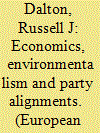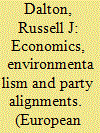| Srl | Item |
| 1 |
ID:
086759


|
|
|
|
|
| Publication |
2009.
|
| Summary/Abstract |
'We are neither Left nor Right, we are out in front' was the mantra of the environmental movement in the 1970s and early 1980s. This research examines the relationship between the traditional left/right economic cleavage and the environmental cleavage in structuring party competition in advanced industrial democracies. It begins by discussing the theoretical rationale for the separation of environmentalism from the traditional economic cleavage, and utilises new expert data to describe the evolution of party positions between 1989 and 2002-2003. An initially strong relationship between party positions on both dimensions in 1989 has strengthened over time. The convergence occurs largely because of changes by Green parties and by the addition of new parties that define themselves on both dimensions. This points to the ability of democratic party systems to integrate a new political cleavage, and the process of integration. However, leftist parties still continue to diverge with respect to how they respond to the environmental cleavage.
|
|
|
|
|
|
|
|
|
|
|
|
|
|
|
|
| 2 |
ID:
086762


|
|
|
|
|
| Publication |
2009.
|
| Summary/Abstract |
'We are neither Left nor Right, we are out in front' was the mantra of the environmental movement in the 1970s and early 1980s. This research examines the relationship between the traditional left/right economic cleavage and the environmental cleavage in structuring party competition in advanced industrial democracies. It begins by discussing the theoretical rationale for the separation of environmentalism from the traditional economic cleavage, and utilises new expert data to describe the evolution of party positions between 1989 and 2002-2003. An initially strong relationship between party positions on both dimensions in 1989 has strengthened over time. The convergence occurs largely because of changes by Green parties and by the addition of new parties that define themselves on both dimensions. This points to the ability of democratic party systems to integrate a new political cleavage, and the process of integration. However, leftist parties still continue to diverge with respect to how they respond to the environmental cleavage.
|
|
|
|
|
|
|
|
|
|
|
|
|
|
|
|
| 3 |
ID:
078404


|
|
|
|
|
| Publication |
2007.
|
| Summary/Abstract |
The alignment of parties within a party system shapes the nature of electoral competition, the process of representation, and potentially the legitimacy of the system. This article describes the distribution of parties and the levels of party polarization in the party systems of East Asian democracies. We examine the public's perceptions of party positions on a left-right scale to map the pattern of party competition. The evidence is based on two waves of surveys from the Comparative Study of Electoral Systems. We describe considerable variation in the polarization of Asian party systems, which has direct implications for the clarity of party choice and the behavior of voters. We conclude with a discussion of the implications of our findings.
|
|
|
|
|
|
|
|
|
|
|
|
|
|
|
|